Slipped Disc: 5 Warning Signs You Shouldn’t Ignore!
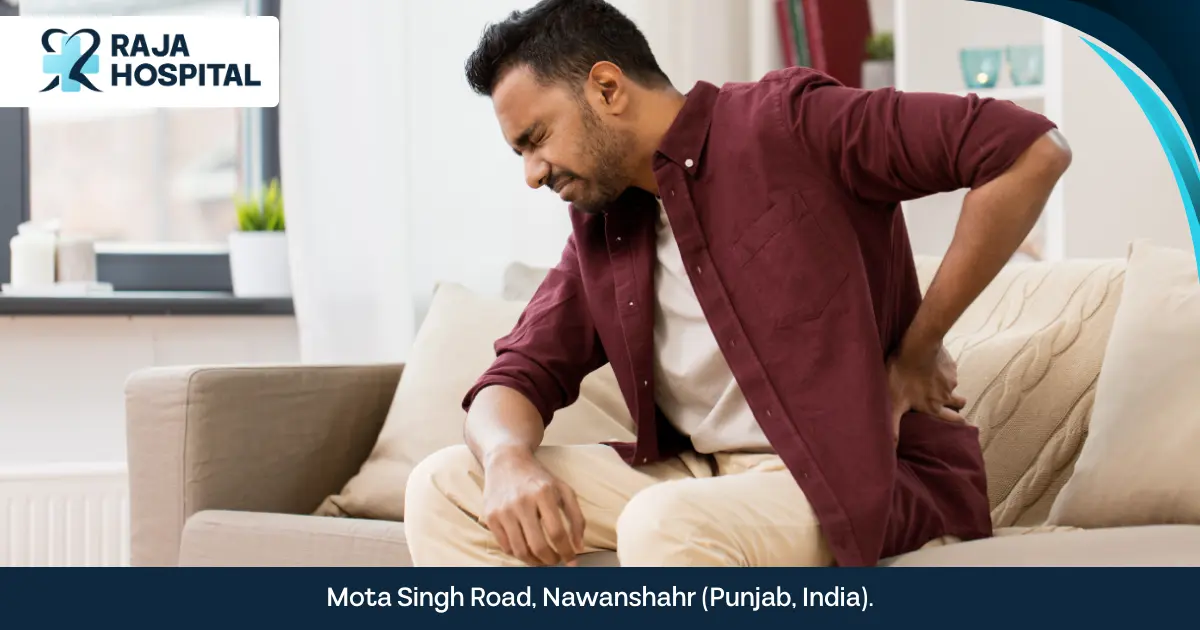
REVIEWED BY Dr. Sunil Duhan (MBBS, D-Ortho) on 19 september 2025.
Back pain sucks. But when it shoots down your leg, makes you feel numb in weird places, or messes with your sleep, it’s more than “just back pain.” It might be a slipped disc.
Here’s the problem: Most people ignore the early signs. Or worse, they try to “walk it off,” thinking it’s a regular strain from sitting too long or lifting something heavy.
But a slipped disc isn’t something to take lightly. It can sneak up on you and turn into a full-blown life disruptor. Suddenly, everyday things like standing, bending, or even sleeping start feeling like a painful chore.
The good news?You don’t need to panic or rush into surgery. In this post, I’ll walk you through 5 warning signs that scream, “Hey, something’s not right!” along with simple things you can do to feel better before it gets worse.
What’s a Slipped Disc (And Why It Hurts So Bad)?
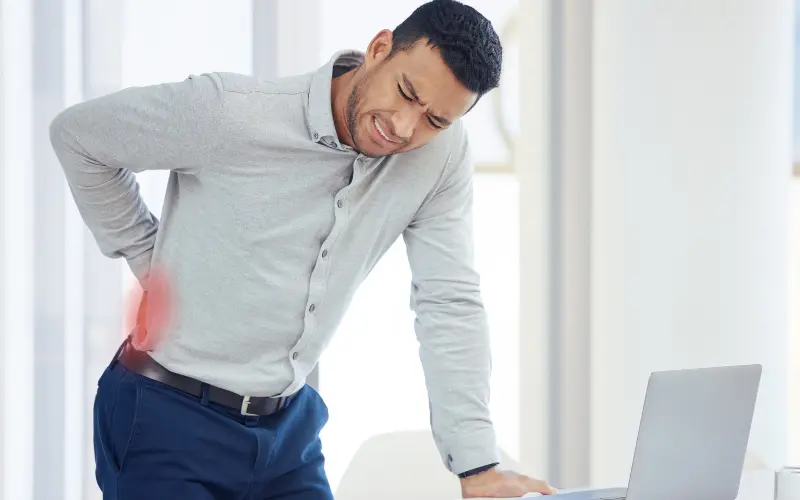
Think of your spine like a stack of bones with jelly-filled cushions in between. These cushions are called discs. They help you bend, twist, and absorb shocks when you move around.
A slipped disc occurs when one of these cushions moves out of place or starts to leak. This can press on nearby nerves, causing pain in your back, neck, arms, or legs.
Not All Back Pain Means a Slipped Disc
Here’s the thing. Just because your back hurts doesn’t mean you have a slipped disc. Sometimes it’s just a tight muscle, a weird sleeping position, or sitting for too long.
So how do you know it’s more serious?
- Muscle pain usually stays in one spot. It feels sore and stiff.
- Slipped disc pain often travels. For example, it might start in your lower back and shoot down your leg.
Slip Disc, Sciatica, or Just Bad Posture?
It can be confusing, so let’s make it simple:
- A slipped disc means one of your spinal discs is pressing on a nerve.
- Sciatica is the pain caused when your sciatic nerve is irritated, often because of a slipped disc.
- Bad posture causes general back pain that usually goes away when you move or stretch.
Figuring out the real cause of your pain is the first step. Next, let’s look at the 5 signs your body might be giving you that it’s time to take your back seriously.
5 Warning Signs You Shouldn’t Ignore
Not all back pain means trouble, but some signs are your body’s way of saying, “Hey, this needs attention.” If you’re dealing with any of these, don’t brush them off.
1. Pain That Travels Down Your Leg or Arm

If your back pain spreads down your leg (sciatica) or arm, that’s a big clue. It usually means a disc is pressing on a nerve, and your body is sending out warning signals.
2. Tingling or Numbness
That pins-and-needles feeling in your hands, feet, or toes? Or feeling like a part of your body is half-asleep? This can be a sign that nerves are being squeezed by a slipped disc.
3. Muscle Weakness
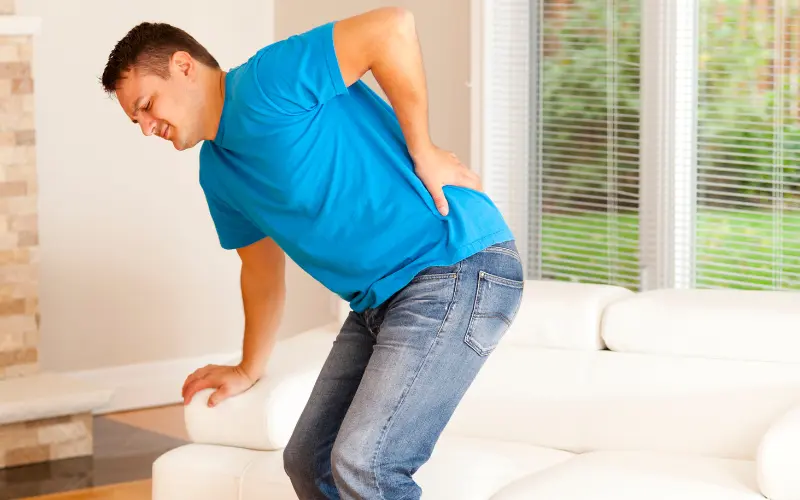
If you suddenly find it hard to lift things, climb stairs, or even grip something properly, that’s a red flag. Nerve pressure can mess with your muscle control.
4. Trouble with Peeing or Pooping
This one’s serious. If you can’t control your bladder or bowels, go to a doctor right away. It might be rare, but it’s a medical emergency and needs quick attention.
5. Pain That Gets Worse When You Sit or Cough
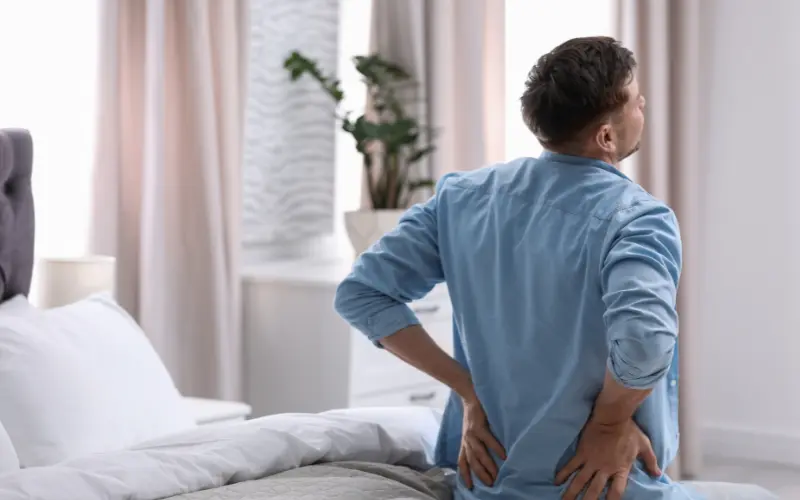
If your pain gets worse when you sit down, bend forward, or cough, it could mean the pressure on your nerves is increasing. That’s a common sign of a slipped disc.
Things You Can Do at Home (No Fancy Stuff Needed)
You don’t need a physio, a gym, or a ton of equipment to start feeling better. Just a little time, some space to move, and the right habits.
Stretching That Feels Good
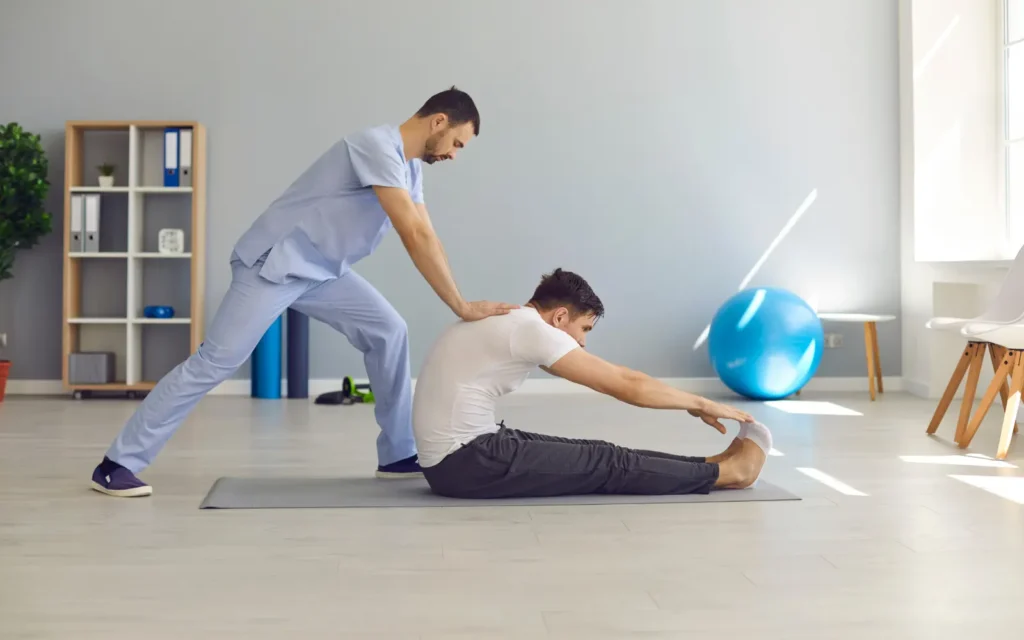
Some stretches can give quick relief. Try these:
- Cat-Cow Stretch: On all fours, arch and round your back slowly. It eases stiffness.
- Knees-to-Chest: Lie on your back and gently pull your knees toward your chest.
- Child’s Pose: Sit back on your heels, arms stretched forward. It gives your spine a break.
Always go slow and stop if anything feels sharp or wrong.
Fix Your Sitting Game
Bad posture is like fuel for back pain. If you sit for long hours, here’s what to do:
- Use a small cushion or rolled towel behind your lower back.
- Keep your feet flat and avoid crossing your legs.
- Don’t slouch or lean too far forward.
Even small changes in how you sit can take pressure off your spine.
Take Mini Breaks Every Hour
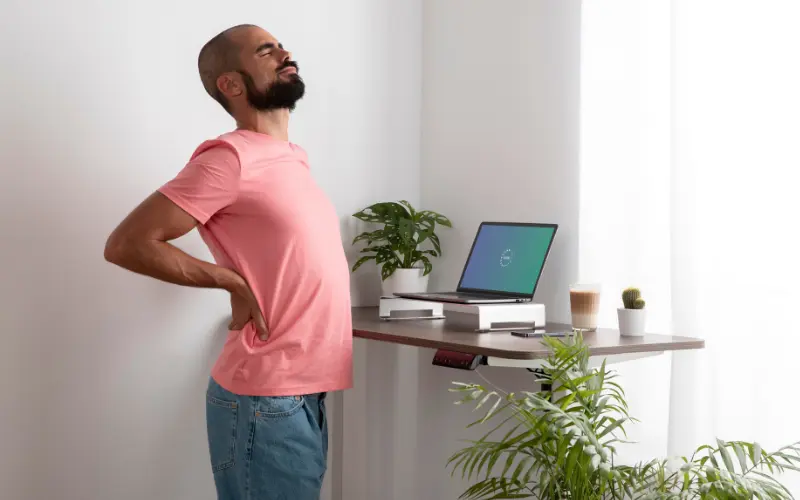
Your spine hates being stuck in one position. Stand up every 30 to 60 minutes, stretch a bit, or walk around your room. These short breaks keep your spine happy and blood flowing.
Small Lifestyle Tweaks That Speed Up Healing
Tiny changes in your daily routine can have a big impact on how fast your back recovers. These aren’t major life overhauls, just smart shifts that support your spine and help your body do its thing.
Sleep in a Way That Supports Your Spine

The way you sleep can either relax your back or strain it even more. A few simple adjustments can make a huge difference.
- Try sleeping on your back with your knees slightly bent.
- If you sleep on your side, put a pillow between your legs.
- Avoid soft, saggy mattresses. A medium-firm surface is best.
Drink More Water Than You Think You Need
Your spinal discs are like little water balloons. When you’re dehydrated, they lose flexibility and cushioning power.
- Aim to drink enough water so your urine stays light yellow.
- Sip throughout the day instead of chugging all at once.
- Herbal teas and fruits like watermelon also help with hydration.
Choose Foods That Fight Inflammation

What you eat can speed up or slow down healing. Focus on food that supports recovery from the inside out.
- Add leafy greens, berries, nuts, and seeds to your meals.
- Eat omega-3-rich foods like fish, chia seeds, or walnuts.
- Cut down on sugar, fried food, and processed snacks.
Lower Your Stress to Help Your Muscles Relax
Stress isn’t just in your head; it tightens your muscles and keeps your nervous system on edge. The more relaxed you are, the faster your body heals.
- Try 10 minutes of deep breathing or meditation daily.
- Walk outdoors, journal, or listen to calming music.
- Laugh often. Yes, even memes and pet videos count.
Your spine responds well to care and consistency. These small lifestyle tweaks might not seem like much, but over time, they create a big shift in how you feel.
Common Myths That Make Things Worse
There’s a lot of bad advice floating around about slipped discs. Some of it sounds convincing, but following it can actually slow down your recovery or make things worse.
Resting All Day Is Not the Solution
It sounds logical if it hurts, rest, right? But too much rest can make your back stiffer and weaker.
- Light movement helps blood flow and healing.
- Short walks or gentle stretches are better than lying down all day.
- Listen to your body, not just your fear.
Cracking Your Back Won’t Fix a Slipped Disc
You might feel the urge to twist or crack your spine for relief, but doing it yourself is risky.
- You could end up irritating your nerves even more.
- Always leave adjustments to trained professionals.
- Focus on controlled movements instead of quick fixes.
Pain Doesn’t Always Mean Damage
Feeling pain doesn’t always mean something is broken or getting worse. It could just be your nervous system being sensitive.
- The brain sometimes “overprotects” the body after injury.
- Some pain during healing is normal, especially when you start moving again.
- Don’t panic over every ache; observe patterns instead.
Frequently Asked Questions
1. Can I really treat a slipped disc at home?
Yes, many slipped discs heal naturally with the right rest, gentle movement, and posture corrections. However, it’s important to monitor symptoms. If the pain gets worse or affects your daily life, it’s time to see a professional.
2. How long does it take to heal a slipped disc naturally?
Most people start to feel better within 4 to 6 weeks with consistent care. For others, especially with severe cases, it might take longer. The key is to stay active (in the right way) and be patient.
3. What should I avoid during recovery?
Avoid lifting heavy objects, twisting your back suddenly, sitting for too long without breaks, or doing high-impact exercises. These can make things worse and slow your healing.
4. Does a slipped disc always need surgery?
No. Surgery is usually a last resort. Most cases respond well to physiotherapy, posture correction, and lifestyle changes. Only in rare, severe cases where nerves are seriously affected, surgery is considered.
5. When should I see a doctor?
If you experience numbness, weakness in your arms or legs, trouble controlling your bladder or bowel, or the pain isn’t improving after a few weeks, it’s time to consult an orthopaedic expert.
Struggling with same?
Book Your Appointment With Our Expert Doctors
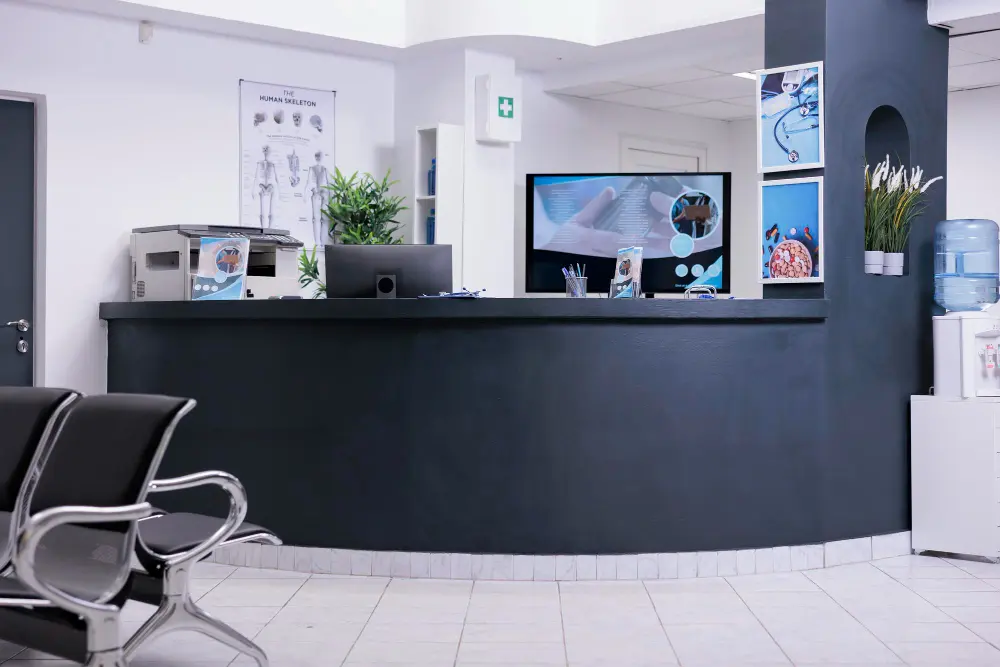
Conclusion
A slipped disc can throw your whole routine off. But most of the time, you don’t need to rush into surgery or expensive treatments.
With the right habits, some gentle movement, and a bit of patience, your body has a great shot at healing naturally.
You’ve now got the knowledge to spot the red flags, avoid common mistakes, and take simple steps at home to support your recovery. And if the pain sticks around or starts to affect your daily life, don’t wait it out.
At Raja Hospital, our orthopaedic experts can help you get the right diagnosis and treatment plan so you can stop guessing and start healing. Book a consultation today and take control of your recovery.
